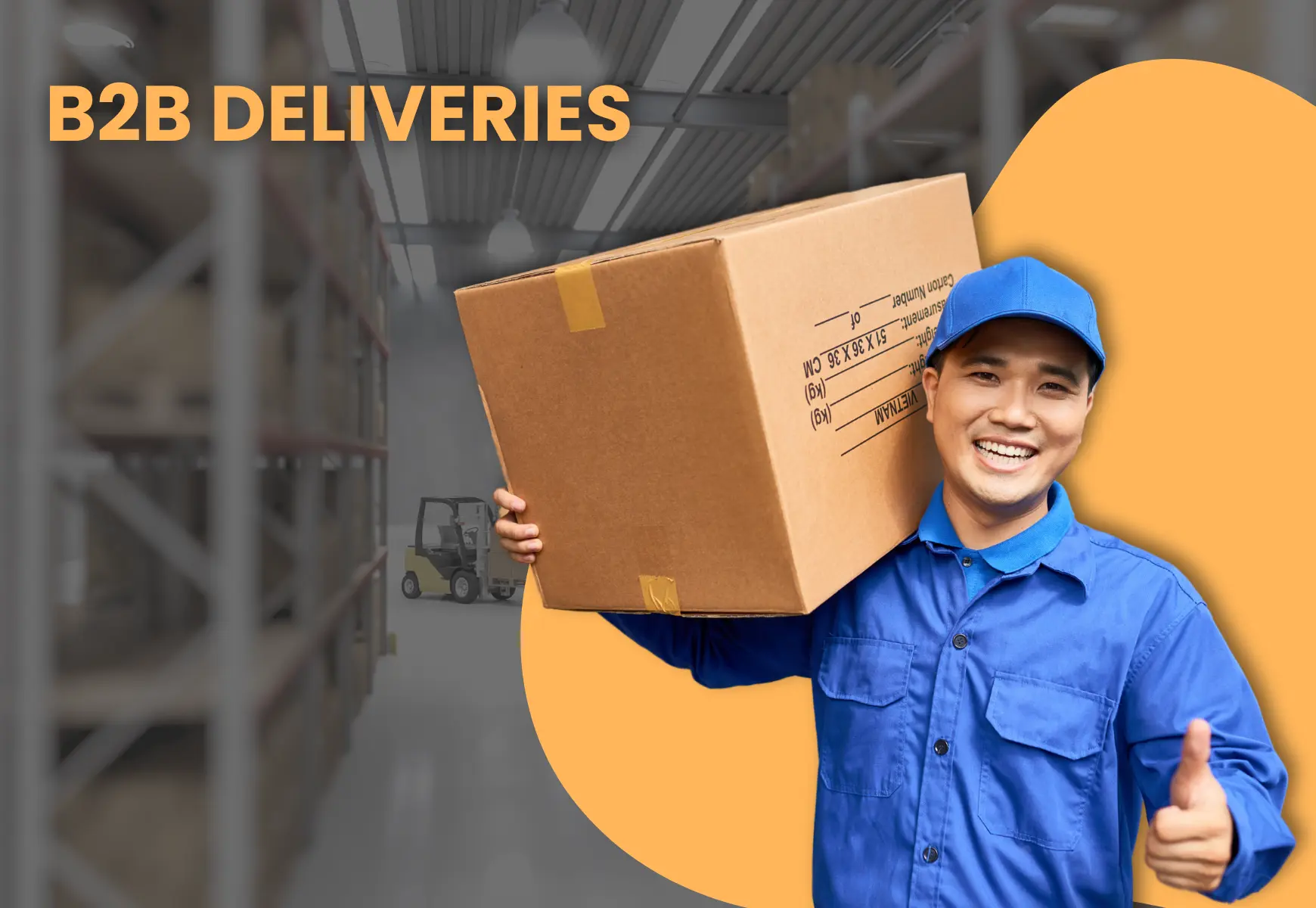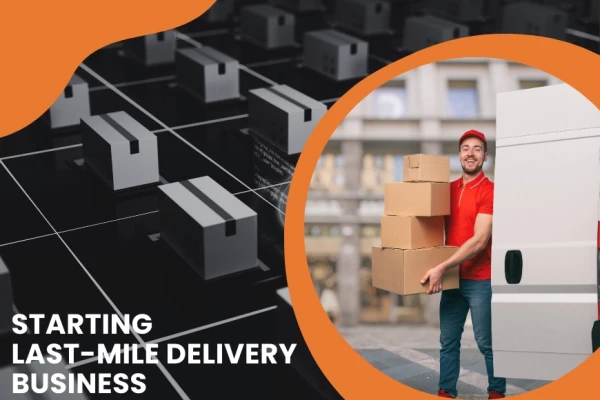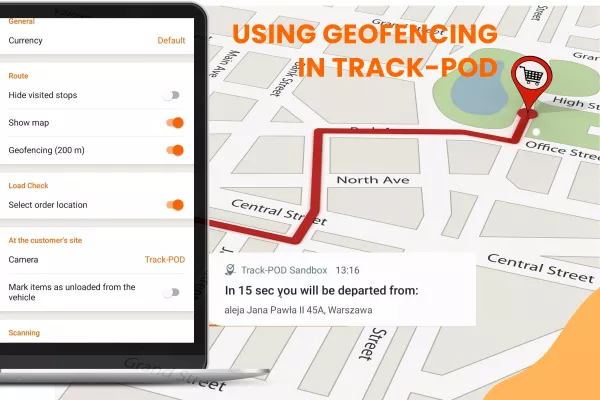Everything You Need to Know About B2B Deliveries

by
Alisa Cvilij
June 10, 2024
Any business offering delivery services needs to ensure that its customers' expectations are met and exceeded. This is true for retail e-commerce stores and companies that offer business-to-business (B2B) deliveries. An efficient delivery process will go a long way in building strong B2B relationships.
Many B2B retailers have been using the Internet for at least two years to carry out their operations, and this trend is expected to continue. Approximately 61% of B2B transactions now start online.
While taking care of your clients can cover many different areas, focusing on meeting their expectations during delivery is essential. This may be easier said than done because B2B deliveries pose many challenges that logistics managers are trying to solve.
How do you deliver on time and in full? How can you account for overdelivery or partial delivery? What parts of the logistics process can you automate to save time?
This guide is all about solving B2B delivery challenges using last-mile logistics software.
Table of contents
1. What is B2B delivery?
2. Example of B2B delivery
3. Understanding B2B deliveries
4. B2B delivery challenges
5. How to improve B2B delivery services?
6. Just-in-time delivery in B2B?
7. Why is efficiency so important in B2B delivery?
8. Trends in B2B deliveries
9. Types of B2B delivery services
10. B2B delivery jobs
What is B2B Delivery?
B2B delivery stands for "Business-to-Business" delivery. In simple words, it means transactions and transportation of goods between businesses. These deliveries often involve larger quantities and happen more frequently than deliveries to individual consumers.
They require careful planning and coordination, including managing warehouses and transportation. B2B deliveries must be flexible and customizable to meet specific business needs.

Example of B2B Delivery
Imagine a bakery that makes a lot of bread and pastries. The bakery needs a constant supply of flour, sugar, and other ingredients to make their products. They might order these ingredients from a wholesale supplier. The wholesale supplier then delivers large quantities of flour, sugar, and other baking essentials directly to the bakery. This delivery from the supplier to the bakery is an example of B2B delivery.
In this case:
- The bakery is one business.
- The wholesale supplier is another business.
- The delivery of ingredients is B2B delivery.
This process helps the bakery continue producing goods, and the supplier continues to sell its products in bulk.
Thus, production companies, wholesalers, and retailers - are the ones where B2B deliveries would be applicable.
Understanding B2B delivery
Delivery is a major challenge for any business. B2C companies put a lot of effort into meeting customers’ expectations and going the extra mile. Last-mile deliveries could cost a business its sales.
When it comes to B2B deliveries, customer experience is often an afterthought. Logistics processes remain unchanged for a long time.
When trying to understand B2B deliveries, the entire supply chain needs to be considered. For example, if a business orders mechanical parts from another business, multiple stages are involved in ordering, manufacturing, and eventually delivering.
Suppliers generally focus on increasing their output. Customer experience is often overlooked.
With big investments into different supply chain processes, it would seem silly not to focus more heavily on customers’ needs. The B2B space is becoming increasingly competitive, and having more distributors means more delivery options.
Focusing on making the delivery experience more customer-centric gives B2B delivery companies a serious competitive advantage.
B2B delivery challenges
Companies must clearly understand the different logistical challenges and how to tackle them to optimize B2B deliveries. Here are some of the main challenges we see in B2B delivery systems.
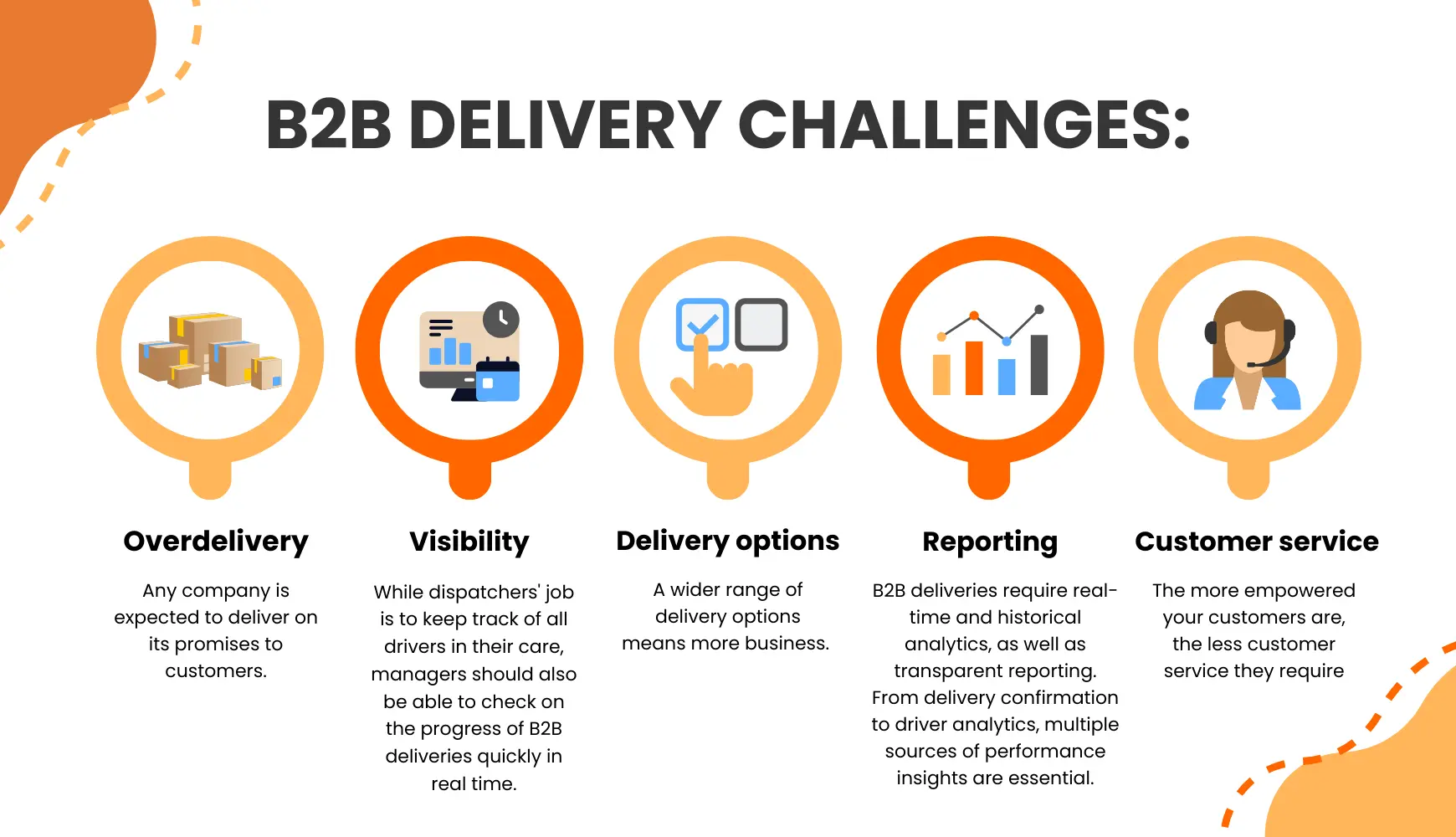
On-time delivery
Any company is expected to deliver on its promises to customers. For B2C companies, meeting delivery expectations is about observing the time slots and ETAs provided to customers at home. Meanwhile, B2B deliveries are often milk runs, i.e., recurring daily/weekly/monthly routes.
In B2B delivery, time slots are fixed and tied to a loading/unloading schedule.
Therefore, Delivery in Full and On Time (DIFOT) becomes the key success metric in B2B courier services.
Overdelivery
Delivery In Full can be a tricky KPI in B2B logistics. Manufacturers, suppliers, wholesalers, and distributors transport large quantities of products from production or warehouse facilities.
While partial delivery is more common in B2C logistics (damaged or wrong goods are rejected upon delivery), overdelivery occurs in B2B logistics.
Being able to account for overdelivery determines the flexibility of a B2B delivery operation.
Visibility
Visibility is always a challenge in any logistics service. There's a dispatcher, a driver, and a customer, i.e., three locations to sync up. In B2B delivery, we're simultaneously talking dozens and hundreds of drivers in the field.
Transparency and visibility are, therefore, essential for efficient logistics management. While dispatchers' job is to keep track of all drivers in their care, managers should also be able to check on the progress of B2B deliveries in real-time quickly.
Delivery options
Unlike B2C deliveries, B2B deliveries often only include a single option for delivery. Businesses can enhance their operations by offering different delivery solutions, such as on-demand or contactless deliveries.
A wider range of delivery options means more business. It also gives the customer more control over their logistics processes, with a clearer window of when to expect their order.
Customer service
As discussed above, customer experience might not be the primary focus for B2B delivery operations. Meanwhile, customer service arises from customer experience.
The more empowered your customers are, the less customer service they require.
B2B courier services can use many tools to empower customers and minimize unnecessary interactions with customer support or sales teams.
Reporting
Your delivery process is only as good as your analytics and reporting. First, there's accountability and supplier relationship management. Second, there's performance analytics and optimization insights.
B2B deliveries require real-time and historical analytics and transparent reporting. Multiple sources of performance insights, from delivery confirmation to driver analytics, are essential.
How to improve B2B delivery services?
B2B delivery companies must be able to respond to the above challenges. Here are some tried-and-tested solutions for enhancing B2B deliveries and logistics.
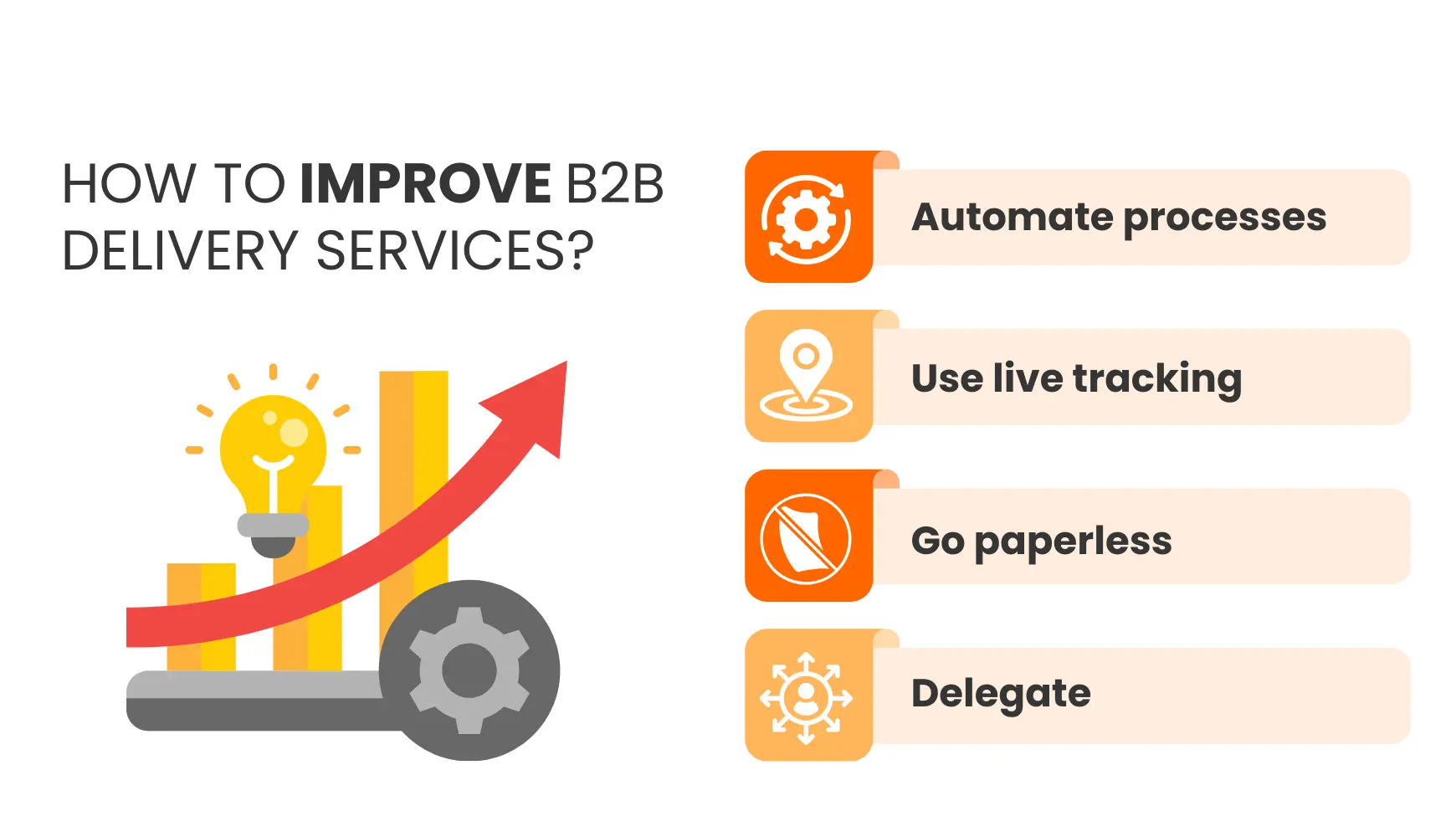
1. Automate processes
Route planning is always a challenge, no matter the destination. Logistics automation is one of the easiest and most effective solutions for multi-stop, multi-vehicle route planning in B2B deliveries.
B2B courier services require advanced route optimization algorithms that automate the job of many people at once.
From route scheduling to load planning and shipping labels - all can be taken care of with automated solutions.
Multi-stop route planners allow businesses to build and optimize each route at the highest level of efficiency. This means faster, cheaper, and safer deliveries organized in seconds by delivery software.
2. Use live tracking
Using a delivery management system allows businesses to track and trace their orders. Customers can easily track their deliveries in real-time instead of calling the supplier and requesting a status update.
At the same time, delivery managers gain a far greater level of control over their operations. They can monitor the status of the delivery route, see updated ETAs, and better control their mobile workforce.
Live tracking is essential in B2B delivery. It results in smoother operations and happier customers.
3. Go paperless
One thing all B2B delivery operations can leave behind is paper. From paper invoices to paper-based reports, everything can be digitalized and streamlined for maximum efficiency.
Paperless driver apps power navigation, live tracking, and delivery confirmation, including partial delivery and overdelivery. They eliminate the need for extra devices, e.g. barcode scanners, and work offline to support all kinds of B2B delivery operations.
Pro tip: a delivery driver app can also support safety management and proactive maintenance with vehicle checklists.
4. Delegate
Because of large order volumes and many stakeholders, B2B delivery management can become out of sync. This is why businesses need to use the right delivery management software to enhance their flexibility.
By giving your B2B customers access to a customer portal, you delegate a good chunk of order management to your shippers. When customers can add and manage their deliveries independently, they save you time and help keep everyone in sync.
Just in time delivery in b2b - it is when?
In simple words, Just-in-Time (JIT) delivery is part of any supply chain plan of a business. It is commonly used by B2B businesses. The idea behind this is to align raw material suppliers' orders with production schedules directly.
However, you need to have precise coordination and strong relationships with suppliers to have a successful JIT delivery. The acceptable time frames for JIT delivery depend on the specific production schedules and demand fluctuations. But, the main goal is to have materials arrive just in time for production.
Suppliers benefit from just-in-time delivery, which helps them build stronger, more cooperative relationships with buyers. This leads to a stable and predictable business setting.
Benefits of JIT for B2B Deliveries
JIT delivery offers several benefits in B2B businesses. These include:
- Reduced Inventory Costs: JIT minimizes the need for large quantities of raw materials or finished goods. By ordering materials only when needed, companies save significantly on storage costs.
- Minimized Waste: JIT helps prevent overproduction, excess inventory, and unnecessary handling. So, by using this method, companies reduce their waste production. This makes operations more efficient and environmentally friendly.
- Enhanced Efficiency: JIT makes production smoother by making sure materials get to the assembly line right when they're needed. This makes things move faster, reduces waiting times, and helps the whole process run better.
- Quality Improvement: JIT encourages rigorous quality control. With smaller batches and frequent deliveries, defects are easier to identify and rectify. High-quality inputs lead to better end products.
Why is efficiency so important in B2B deliveries?
B2B buyers place orders to fulfill certain tasks for their businesses. They need excellent order fulfillment to support their supply lines and keep their own customers happy.
If an order is late, it can disrupt the entire supply line and cause costly delays.
B2B buyers generally maintain close working relationships with their suppliers. To earn loyalty and a long-lasting relationship, B2B deliveries must be efficient and meet the client’s expectations. If deliveries mess with the buyer’s schedule, they will likely source another supplier.
While B2C deliveries generally operate off the stock on hand, B2B orders are often more specialized. This means the entire supply chain related to the order needs to be optimized. Once the order is ready to be shipped, efficient delivery is essential for fulfilling the customer’s demands.
Trends in B2B deliveries
B2B delivery companies always seek ways to minimize costs and maximize efficiency. Below are some important trends within the B2B delivery sector.
Faster order fulfillment
Like B2C orders, B2B buyers expect faster orders and more efficient service. As a result, B2B suppliers are under more pressure to execute faster orders for their clients.
Local distribution
Companies are looking for ways to avoid disruptions in supply. One way to overcome broken supply lines is to source and distribute locally, minimizing risks and improving fulfillment times.
Outsourcing
Many B2B companies lack the resources to fulfill an increasing delivery demand. Outsourcing and sharing delivery resources is becoming a more widely recognized practice.
Quick Delivery (Q-Commerce)
Quick delivery or Q-Commerce is quickly becoming dominant in the eCommerce sector. Nowadays, customers not only expect fast deliveries but also accuracy. In 2024, companies will focus on local distribution centers and advanced delivery technologies to meet these expectations.
Real-Time Tracking
Imagine always knowing where your delivery is at any given moment. Real-time tracking offers this peace of mind. Businesses can pinpoint the exact location of their deliveries, which builds trust with clients and reduces the stress and uncertainty about when packages will arrive. This transparency is expected to increase as the technology becomes more sophisticated.
Sophisticated GPS Systems
Think about the last time you needed to get somewhere fast. You probably relied on a GPS to find the quickest route. Businesses are doing the same with advanced GPS technology for their deliveries. These systems find the most efficient paths, reducing delivery times, saving fuel, and cutting costs. This is crucial, especially in busy cities or remote areas where getting lost is not an option.
Notifications of Arrivals
Wouldn't it be great to know exactly when your package will arrive? Automated alerts do just that. They inform businesses when a delivery is nearby or has been completed. This way, businesses can prepare for the arrival, ensuring someone is there to receive the package, which reduces the chances of missed deliveries.
Delivery Scheduling
Imagine being able to choose exactly when your deliveries will arrive. Delivery scheduling allows businesses to do just that. This flexibility is a game-changer, helping businesses manage their inventory and operations more effectively. By scheduling deliveries during off-peak hours, businesses can avoid disruptions and ensure a smoother workflow.
Self-Delivery vs. Third-Party Delivery
Finally, businesses must handle deliveries themselves or outsource to third-party services. Self-delivery means more control over the process. However, third-party delivery services can be more cost-effective, especially for large volumes or specialized needs. The trend here is towards a balanced approach, with businesses choosing a mix of both depending on their specific needs and resources.
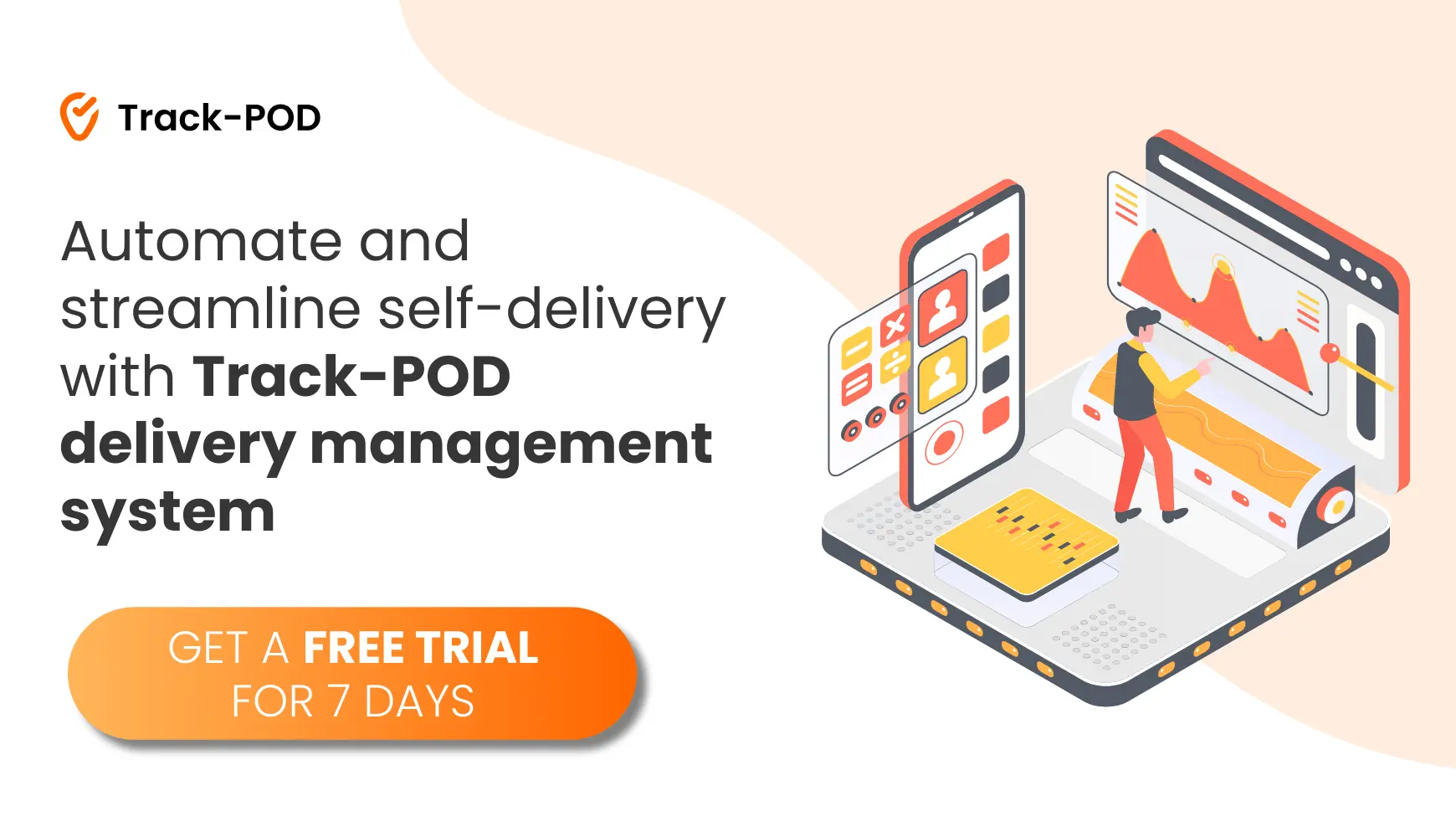
Types of B2B Delivery Services
See below some of the B2B delivery service types:
- B2B Next-Day Delivery: The best option is the next-day delivery service. Nowadays, most businesses need the products either the same day or the next day at the earliest. Due to this, it has become one of the most used and important delivery methods for both the B2C and B2B market segments.
- B2B White Glove Delivery: Next up is white glove delivery. This service goes beyond standard shipping and ensures that shipments arrive with the utmost care, right to the room of choice. This service is essential for delicate items like lab equipment or fine furniture.
- B2B Food Delivery: As the name suggests, this type of delivery connects food services with suppliers. It allows businesses to handle buying and selling food items more efficiently.
- And many more depending on the industry and how fast deliveries should be handled
B2B Delivery Jobs
Moreover, B2B delivery jobs have also become quite prevalent. They have become essential to a supply chain operation and timely deliveries. These roles involve delivering goods to other businesses (B2B) or handling logistics for B2B clients. A couple of jobs include:
Supply Chain Logistics Coordinator
A Supply Chain Logistics Coordinator ensures the efficient flow of goods between businesses by managing order processing, inventory levels, shipment coordination, and supplier relationships. They play a crucial role in maintaining smooth operations and preventing any issues from happening in the supply chain.
Field Service Technician
A Field Service Technician installs, maintains, and provides technical support for specialized equipment at client sites. They ensure the equipment functions correctly, provide training, and respond to service calls, helping businesses maintain productivity and minimize downtime.
These jobs are available on multiple sites where anyone with a license can apply. Here are a few examples of popular online job boards and websites where licensed professionals can find job opportunities:
- LinkedIn
- Indeed
- Glassdoor
- SimplyHired
- FlexJobs
- Upwork
Wrapping up
B2B deliveries require plenty of attention if businesses want to keep their clients happy. The delivery landscape is developing rapidly, with demands consistently rising. B2B companies need to respond to this and enhance their delivery schedules to keep up with the fast-paced sector.
Better deliveries result in happier clients and improved profitability. By optimizing the delivery process, businesses will be able to see a major difference in their growth and revenue.
Technology helps to save time, automate and streamline B2B deliveries, thus with the Track-POD delivery management platform you can get:
- Route Optimization considering truck load check, available vehicles, and delivery times;
- Live Tracking for both dispatchers and customers;
- Custom and branded live tracking and notifications for the customers;
- Driver app with proof of delivery and barcode scanner.
About The Author
Alisa Cvilij
Content Marketer at Track-POD. Passionate about building meaningful and helpful content for the readers.

